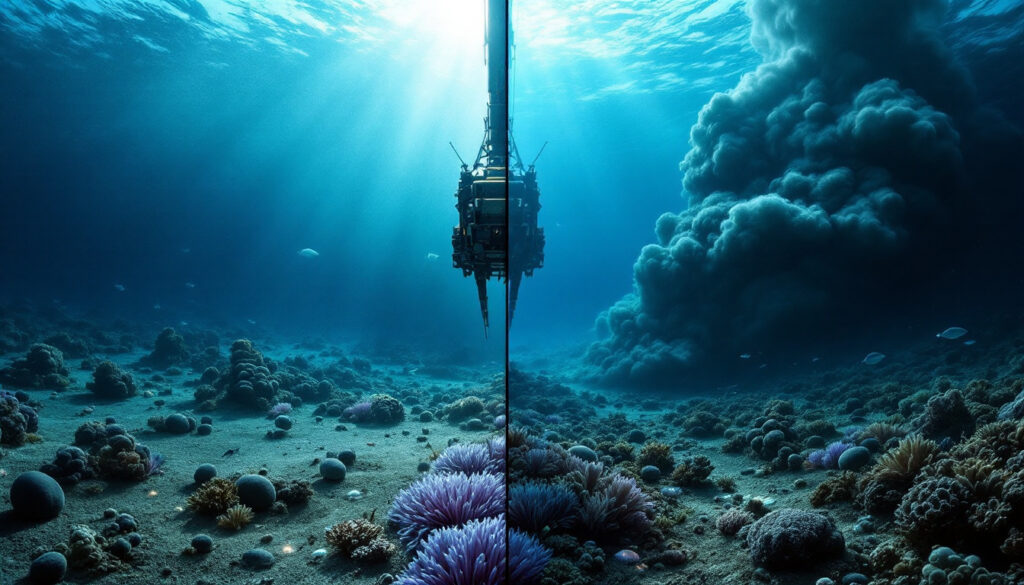What Are Manganese Nodules?
Manganese nodules are mineral concretions found on the ocean floor composed of concentric layers of iron and manganese hydroxides around a core. These remarkable formations are often described as "polymetallic nodules" due to their diverse mineral composition. They vary in size from microscopic particles to large pellets exceeding 20 centimeters across, though most fall within the 3-10 cm diameter range.
These nodules form through an extraordinarily slow process, growing at rates of only 2-5 millimeters per million years for hydrogenetic nodules and about 10 millimeters per million years for diagenetic types. This glacial pace of formation means that nodules being considered for mining today began forming when dinosaurs still roamed the Earth.
"Nodules form through redox oscillations driven by abiotic and biotic processes," according to oceanographic studies, highlighting the complex chemistry involved in their creation. Their composition includes valuable metals in significant concentrations: 27-30% manganese, 1.25-1.5% nickel, 1-1.4% copper, and 0.2-0.25% cobalt, making them attractive targets for extraction.
Formation and Composition of Manganese Nodules
The formation of manganese nodules occurs through two primary mechanisms:
-
Hydrogenetic nodules: Form through direct precipitation from seawater, characterized by higher iron and cobalt content with Mn:Fe ratios less than 2.5. These typically grow more slowly at 2-5 mm per million years.
-
Diagenetic nodules: Form from sediment pore water flux, enriched with manganese, nickel, and copper with Mn:Fe ratios between 2.5-30+. Their growth rate is slightly faster at approximately 10 mm per million years.
Most nodules contain a mixture of both types, with diagenetic layers typically on the bottom where they contact sediment and hydrogenetic layers toward the top where they're exposed to water. This creates a distinctive layered structure visible under microscopic examination.
The unique phyllomanganate mineral structure of these nodules enables trace metal adsorption via cation exchange, making them natural repositories for metals that have accumulated over millions of years. This unique redox chemistry driving metal precipitation explains why nodules contain such high concentrations of valuable metals compared to most terrestrial ores.
Where Are Manganese Nodules Found?
Manganese nodules occur in various ocean basins worldwide, though their distribution is notably patchy due to topographic and sedimentologic diversity. They typically form in areas with low sedimentation rates and consistently oxygenated water, conditions found primarily in the abyssal plains of the world's oceans.
The most economically significant deposits are located in:
-
The Clarion-Clipperton Zone (CCZ) in the North Central Pacific Ocean, spanning approximately 4 million square kilometers (roughly the size of the European Union)
-
The Peru Basin in the Southeast Pacific, known for its diagenetically enriched nodules
-
The Indian Ocean Nodule Field (IONF) in the Southern Tropical Indian Ocean near Diego Garcia
-
The Cook Islands' Penrhyn Basin, containing high-grade nodules within their Exclusive Economic Zone
-
Areas around Juan Fernández Islands and offshore the Loa River in the Eastern Pacific
"The CCZ contains 44 million tons of cobalt—three times global land reserves," according to resource assessments, underscoring the strategic importance of these underwater resources. The CCZ alone represents the largest deposit, containing an estimated 21 billion tons of nodules with approximately 5.95 billion tons of manganese, 270 million tons of nickel, 230 million tons of copper, and 50 million tons of cobalt.
Interestingly, nodule fields found in the Baltic Sea (shallow water) differ significantly in composition from those in the deep-ocean Clarion-Clipperton Zone, demonstrating how formation conditions influence mineral content.
How Does Manganese Nodule Mining Work?
Proposed mining operations for manganese nodules involve a complex system of seafloor collection, vertical transport, processing, and shipping. The technological challenges are immense, given the extreme depths (typically 4,000-6,000 meters) and hostile conditions of the abyssal environment.
The mining process includes several key components:
-
Collection vehicles (ROVs/AUVs) that scour the seafloor to harvest nodule-bearing sediment, disturbing 200-600 square kilometers annually per contract area
-
Vertical transport systems (risers) to bring nodules to surface vessels, creating midwater plumes during operation
-
Separation systems that process the nodules and return approximately 90% of sediment to the seafloor
-
Transport vessels to move the processed materials to land-based processing facilities
"Mining resembles a potato harvest, with tools collecting nodules in narrow strips," as one industry expert describes it. The collection vehicles move across the seabed in long, narrow strips while support vessels follow their route above. Slurry containing nodules is pumped to the surface, where the valuable material is separated from sediment and water.
Lockheed Martin's prototype collector trials in the CCZ and other experimental operations have demonstrated the technical feasibility of such operations, though full-scale commercial mining has yet to commence. The Metals Company (formerly DeepGreen) has conducted pilot operations that provide insights into the practical challenges of deep-sea mining.
What Are the Environmental Impacts of Mining Manganese Nodules?
Destruction of Seabed and Habitat
The most direct impact of manganese nodule mining is the physical destruction of the seabed habitat. Collection vehicles destroy the top layer of the seabed at depths exceeding 3 kilometers, creating a severely disturbed environment.
Studies of experimental mining sites, including the DISCOL experiment from 1989, show that mining tracks remain visible decades after disturbance. The microbially-mediated biogeochemical functions require over 50 years to return to their undisturbed state, according to a 2020 study on microbial community recovery post-mining.
"Nodule removal eliminates critical hard substrate for endemic species," marine biologists warn, noting that approximately 80% of CCZ macrofauna are nodule-dependent. The nodules themselves serve as critical hard substrate habitat for many deep-sea species, and their removal effectively eliminates this habitat for millions of years.
Sediment-Laden Plumes
Mining operations generate plumes of sediment that can have far-reaching impacts on marine ecosystems:
-
Plumes contain both dissolved material and suspended particles of various sizes
-
Finer particles and dissolved materials can be transported hundreds of kilometers from mining sites
-
Sediment can smother filter-feeding organisms and clog their feeding mechanisms
-
Discharge plumes created during dewatering processes on surface vessels add additional impacts to mid-water ecosystems
The toxic metal release (e.g., lead, cadmium) from reductive dissolution of disturbed sediments poses additional risks. Scientists warn that sensitive deep-sea organisms have evolved in an environment with minimal sediment disturbance, making them particularly vulnerable to mining-induced turbidity.
Noise Pollution
Mining operations introduce significant noise into the normally silent deep-sea environment, creating another form of pollution that is often overlooked:
-
Many marine animals use sound as their primary mode of communication and navigation
-
"Noise from machinery disrupts deep-sea fauna reliant on sound," bioacoustic specialists have noted
-
Background noise can limit animals' ability to detect prey or communicate with potential mates
-
Noise sources include seabed production tools, midwater transport systems, and surface vessels
With mining contracts typically lasting 20-30 years, continuous noise generation could create chronic stress for marine species across vast areas. This is particularly concerning for deep-diving cetaceans and other acoustically sensitive species.
Light Pollution
Deep-sea mining introduces artificial light into a naturally dark environment where many species have evolved without exposure to light:
-
Strong lights are required to make undersea mining operations possible
-
Artificial light can attract or repel certain animal species, disrupting natural behavior
-
Bright lights can blind or disorient deep-sea animals adapted to darkness
-
Surface vessel lighting can affect birds and near-surface animals
Light pollution is particularly problematic for bioluminescent species that rely on light signals for communication, attracting prey, or avoiding predators. The introduction of artificial light sources could disrupt these delicate ecological interactions.
Reduced Oxygen Content
Recent research suggests manganese nodules may influence oxygen dynamics in deep-sea environments:
-
Studies have proposed that nodules might contribute to "dark oxygen" (oxygen produced without light)
-
If nodules produce significant oxygen, their removal could impact oxygen availability
-
This could affect communities dependent on this oxygen source
-
However, this finding is contested by other researchers who question the significance of any nodule-related oxygen production
This debate illustrates the significant knowledge gaps that still exist regarding the ecological functions of deep-sea nodule fields and the potential consequences of their removal.
What Are the Long-Term Ecological Concerns?
Recovery Potential of Seabed Ecosystems
The slow recovery of deep-sea ecosystems is a major concern when assessing the long-term impacts of nodule mining:
-
Nodules grow at rates of only 2-10 mm per million years, meaning they are effectively non-renewable on human timescales
-
Many deep-sea species are rare, long-lived, and slow to reproduce, with xenophyophores and other organisms having extremely limited reproductive rates
-
The hard substrate provided by nodules will not return for millions of years
-
"Ecosystem recovery is unlikely on human timescales," according to marine ecologists studying the issue
A 1997 plume impact study in the Peru Basin and other long-term monitoring of experimental mining sites have consistently shown minimal recovery decades after disturbance. This suggests that mining impacts should be considered permanent from a human perspective.
Broader Ecosystem Impacts
Mining activities could disrupt complex ecological relationships that have evolved over millions of years:
-
Polymetallic nodule fields are hotspots of abundance and diversity for abyssal fauna
-
"Abyssal plains are biodiversity hotspots with high endemism," contrary to earlier assumptions about limited biodiversity in these regions
-
Mining could affect tens of thousands of square kilometers of deep-sea ecosystems over the lifespan of mining operations
-
Carbon sequestration disruption via sediment carbon release could have implications for oceanic carbon cycles
The complexity of deep-sea food webs, combined with the remoteness of these environments, creates significant knowledge gaps in our understanding of potential cascading ecological effects. The International Union for Conservation of Nature (IUCN) has begun developing Red List assessments for hydrothermal vent species, but most nodule field organisms remain poorly studied and unevaluated for extinction risk.
How Can Environmental Impacts Be Mitigated?
Several approaches have been proposed to reduce the environmental impacts of manganese nodule mining, though their effectiveness remains largely theoretical until large-scale testing occurs:
-
Reducing the weight of mining vehicles to minimize compaction and sediment disturbance, with lightweight collectors potentially reducing sediment compaction by up to 40%
-
"Leaving 20% of nodules intact preserves habitat connectivity," according to conservation biologists, who recommend leaving some areas of nodules untouched to preserve habitat
-
Distributing manufactured replacement nodules, though "artificial nodules lack microbial communities, limiting restoration efficacy"
-
Implementing closed-loop processing systems to minimize surface discharge of mining waste
-
Utilizing real-time plume monitoring via autonomous underwater vehicles (AUVs) to manage sediment dispersion
The European Union's MIDAS project has developed mitigation guidelines that provide a framework for environmental management, though implementation remains challenging in international waters.
Research Gaps and Future Directions
Significant knowledge gaps remain regarding deep-sea ecosystems and mining impacts:
-
More research is needed on deep-sea ecosystem structure and function before large-scale mining begins
-
Better understanding of recovery rates and processes is critical for realistic impact assessment
-
Development of more environmentally-friendly mining technologies should be prioritized
-
Establishment of protected areas to preserve representative habitats has begun, with 30% of the CCZ designated as "Areas of Particular Environmental Interest"
-
Long-term monitoring of experimental mining sites is essential but currently limited
The International Seabed Authority (ISA) has been developing environmental regulations for mining in international waters, though many scientists argue that current knowledge is insufficient to establish effective protective measures.
Economic Interest vs. Environmental Concerns
The Economic Value of Manganese Nodules
The growing demand for metals used in renewable energy and technology drives interest in nodule mining:
-
Electric car batteries, wind turbines, and solar panels require metals found in nodules
-
Cobalt demand is projected to increase by 800% by 2050 for renewable technology applications
-
The Clarion-Clipperton Zone alone contains about 44 million tons of cobalt (three times current land reserves)
-
"Terrestrial ore grades decline as seabed resources gain feasibility," making deep-sea resources increasingly economically attractive
-
Life-cycle assessments suggest nodules offer 94% lower CO₂ emissions for nickel and copper production compared to land-based mining
The transition to renewable energy and digital technologies is creating unprecedented demand for the very metals contained in manganese nodules, creating a paradoxical situation where environmental goals on land may drive environmentally questionable extraction in the ocean. Understanding the complexities of ore deposit geology is essential for evaluating these tradeoffs.
Growing Opposition to Nodule Mining
Despite economic potential, there is significant opposition to deep-sea mining:
-
Environmental organizations warn of irreversible ecosystem damage
-
Major companies including Samsung and BMW have committed to avoid using metals from nodules in their supply chains
-
"Biotech potential of deep-sea organisms risks irreversible loss" if mining proceeds before proper bioprospecting
-
The International Seabed Authority continues developing regulations, though many scientists and NGOs call for moratoriums
-
In 2021, Nauru announced plans to exploit nodules, triggering the "two-year rule" requiring the ISA to finalize mining regulations, creating tension between development interests and environmental protection
The debate highlights fundamental questions about how humanity should balance resource extraction with environmental protection, particularly in remote ecosystems that remain poorly understood. Furthermore, the industry faces significant mining ESG challenges that must be addressed before operations can proceed.
FAQ About Manganese Nodule Mining
How do manganese nodules form?
Manganese nodules form through precipitation of primarily iron, manganese, nickel, copper, cobalt, and zinc around a nucleus. Formation occurs through hydrogenetic processes (precipitation from water column) or diagenetic processes (precipitation from sediment pore water). Growth is extremely slow, with hydrogenetic nodules growing at approximately 2-5 mm per million years and diagenetic nodules at about 10 mm per million years. The phyllomanganate mineral structure enables these nodules to act as natural metal collectors over geological timescales.
Why are manganese nodules valuable?
Manganese nodules contain high concentrations of economically valuable metals including manganese (27-30%), nickel (1.25-1.5%), copper (1-1.4%), and cobalt (0.2-0.25%). These metals are essential for renewable energy technologies, electronics, and batteries. As terrestrial sources become depleted or lower grade, deep-sea nodules represent a significant alternative resource. The CCZ alone contains enough cobalt to supply global demand for centuries at current consumption rates.
What is the current status of manganese nodule mining?
Currently, no commercial-scale mining of manganese nodules is taking place. Several companies and countries have exploration contracts, particularly in the Clarion-Clipperton Zone. The International Seabed Authority is developing regulations for deep-sea mining following Nauru's invocation of the "two-year rule" in 2021. Environmental impact assessments from companies like Global Sea Mineral Resources (GSR) are under review, but full-scale commercial extraction remains years away pending regulatory frameworks and technology development. Proper mining feasibility insights are crucial for understanding the economic viability of these projects.
How might deep-sea mining affect climate change?
The relationship between deep-sea mining and climate change is complex. Mining could provide metals needed for renewable energy technologies, potentially reducing carbon emissions from the energy sector. Life-cycle assessments suggest nodule mining might produce 94% lower CO₂ emissions for nickel and copper compared to land-based extraction. However, disturbing deep-sea ecosystems could release stored carbon from sediments and disrupt carbon cycling in ways not fully understood. Additionally, mining operations themselves would generate emissions through vessel operations and processing. More research is needed to understand the full climate implications, especially in relation to green mining innovations.
Can deep-sea ecosystems recover from mining impacts?
Deep-sea ecosystems have extremely slow recovery rates. Studies of experimental mining sites show that tracks remain visible decades later, and microbial communities require over 50 years to recover. The nodules themselves grow at rates of millimeters per million years, meaning the hard substrate habitat they provide would effectively be permanently removed. With approximately 80% of CCZ macrofauna being nodule-dependent, habitat loss could lead to local extinctions. Many scientists believe complete ecosystem recovery is not possible on human timescales, making mining
Interested in Discovering the Next Major Mining Opportunity?
Discovery Alert's proprietary Discovery IQ model instantly identifies significant ASX mineral discoveries, delivering real-time alerts that transform complex geological data into actionable investment insights. Explore how major mineral discoveries can lead to substantial market returns by visiting the dedicated discoveries page and begin your 30-day free trial today.




